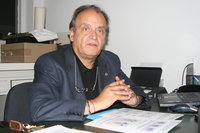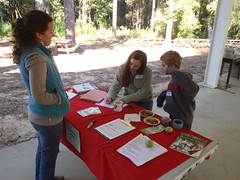Continue readingCommentary
A Call for Skepticism
by Steven K. Roberts
Camano IslandIf ever we needed a demonstration that the fundamental flaw in many arguments is a lack of discrimination regarding information sources, we have it in the Nels Konnerup article, “Toxicology 101 Defended,” in the March 26 issue of the S/C News.
The author makes a “plea for cogent thought, rather than a visceral reaction to the use of pesticides and herbicides,” and cites a number of references “authored by highly qualified and respected scientists.” So far, so good.
But just for fun, I spent a few minutes researching some of these sources to see if I could determine the affiliations and biases of their authors.
Category Archives: Science
Germans document glysophate poisoning
 The promise of Roundup:
The promise of Roundup:
“No tilling, just seed, spray, and harvest.”Adriana Alvarez, who lives next door to an Argentinia GM soy field, says:
“They came from this side and sprayed the entire field. Here he turns, spraying all the time.”The farmer was wearing a mask. That’s more than no-till farmers around here do.
Interesting statistic that in Argentina
soy production increased
35-fold between
1996 and 2003
while Roundup use increased
56 times.
 And eventually it doesn’t work at all, because it breeds resistant weeds.
In Georgia it took only ten years to produce
mutant pigweed
that not just Roundup but not even paraquat can kill.
Many farmers are realizing that
it’s cheaper, more effective, and more profitable to plow the weed under
in the fall and plant a winter cover crop.
Even mutant weeds are not resistant to cold steel.
And eventually it doesn’t work at all, because it breeds resistant weeds.
In Georgia it took only ten years to produce
mutant pigweed
that not just Roundup but not even paraquat can kill.
Many farmers are realizing that
it’s cheaper, more effective, and more profitable to plow the weed under
in the fall and plant a winter cover crop.
Even mutant weeds are not resistant to cold steel.
The documentary points out many products in German stores that include GM soy. In Argentina, it’s even worse, with increasing numbers of birth defects.
 They interview
Prof. Andrés Carrasco about his research on amphibians:
They interview
Prof. Andrés Carrasco about his research on amphibians:
“The hemispheres do not separate, like you can see here. If you look closely you can see one brain. Glyphosate can cause this kind of mechanisms, for it is an enzymatic toxin.”
Monsanto refused an interview, responding in writing:
As Dr. Carrasco has been known to say:“Monsanto is convinced of the safety and usefullness of its products and its contribution to efficacious agriculture.”
“Son hipócritas, cipayos de las corporaciones, pero tienen miedo. Saben que no pueden tapar el sol con la mano.”“They are hypocrites, those corporate lackeys, but they are afraid. They know they can’t cover the sun with their hand.”
 The documentarians interviewed
Gilles-Eric Seralini in Caen, France.
The documentarians interviewed
Gilles-Eric Seralini in Caen, France.
“To human cells glyphosate is already toxic in a very low dose. A farmer uses a much higher dose on the field. Roundup is even more toxic than glysophate, for that is only one of the ingredients in Roundup.”Roundup says none of this applies to humans and Roundup is safe. Seralini says:
“Transgenics are toxic for human health.”
 This is the same Monsanto that
made Fox rewrite 80 times about RBGH in Florida cows.
This is the same Monsanto that
made Fox rewrite 80 times about RBGH in Florida cows.
![]() The same Monsanto that
was convicted by the French Supreme Court of lying about leaving the soil clean.
The same Monsanto that
was convicted by the French Supreme Court of lying about leaving the soil clean.
 The same Monsanto that
was fined $2.5 million by the U.S. EPA for
selling genetically modified cotton seeds without labeling them as such.
The same Monsanto that
was fined $2.5 million by the U.S. EPA for
selling genetically modified cotton seeds without labeling them as such.
Who should you believe? A corporation repeatedly convicted of deception, or scientists who say that GM crops cause liver and kidney damage in animals, according to research using Monsanto’s own data.
 The Roundup-spraying farmer said:
The Roundup-spraying farmer said:
Roundup, mas algo! mas algo!It’s time to say:Roundup, more and more!
Ya basta!Enough already!
-jsq
PS: Credits to the German TV consumer series ‘plus minus’:
GM toxic soy in animal feed broadcast (© WDR) by Detlef Flintz and Mathias Rauck. Translation and highlighting provided by TraceConsult. Broadcast Tue, 08 Feb. 2011 | 9:50 PM.Bericht
D. Flintz
M. Rauck
Kamera
J. Fenske
C. Kültür
J. Midú
Schnitt
H. Bischoff
E. Elsner
Rumsfeld’s Legacy: Aspartame and brain cancer
 In honor of Donald Rumsfeld’s memoir, here’s another part of his legacy:
as president of G.D. Searle,
Rumsfeld got the FDA to approve aspartame
(aka Nutra-sweet, Equal, or Canderel),
shortly after Reagan was elected, despite massive evidence that it
caused cancer.
Don’t believe me,
listen to Mike Wallace:
In honor of Donald Rumsfeld’s memoir, here’s another part of his legacy:
as president of G.D. Searle,
Rumsfeld got the FDA to approve aspartame
(aka Nutra-sweet, Equal, or Canderel),
shortly after Reagan was elected, despite massive evidence that it
caused cancer.
Don’t believe me,
listen to Mike Wallace:
Or consider Hesh Goldstein’s opinion:
“If Donald Rumsfeld had never been born think of how many millions of people the world over would not suffer headaches and dizziness. Thousands blind from the free methyl alcohol in aspartame would have sight, and there would be much fewer cases of optic neuritis and macular degeneration. Millions suffering seizures would live normal lives and wouldn`t be taking anti-seizure medication that won’t work because aspartame interacts with drugs and vaccines. Think of the runner, Flo Jo, who drank Diet Coke and died of a grand mal seizure. She, no doubt, would still be alive. Brain fog and memory loss, skyrocketing symptoms of aspartame disease, would not be epidemic.”What’s not opinion is that aspartame includes methyl acohol and other toxic and carinogenic chemicals.
Rumsfeld sold G.D. Searle to Monsanto in 1984 Continue reading
Growing Local Morning in Tifton
 Checking in Saturday morning, 13 Nov 2010,
at the Growing Local Conference organized
by Georgia Organics in Tifton, Georgia.
Checking in Saturday morning, 13 Nov 2010,
at the Growing Local Conference organized
by Georgia Organics in Tifton, Georgia.
 Janisse Ray and Leeanne Culbreath explain the conference.
Janisse Ray and Leeanne Culbreath explain the conference.
Pesticides Linked to ADHD
Researchers tracked the pesticides’ breakdown products in children’ urine and found those with high levels were almost twice as likely to develop ADHD as those with undetectable levels.Then they try to greenwash the problem by saying to wash food before eating. Sure, that will help a bit, but many of the chemicals are inside the food, not just on it.The findings are based on data from the general U.S. population, meaning that exposure to the pesticides could be harmful even at levels commonly found in children’s environment.
“There is growing concern that these pesticides may be related to ADHD,” said researcher Marc Weisskopf of the Harvard School of Public Health, who worked on the study.
“What this paper specifically highlights is that this may be true even at low concentrations.”
Organophosphates were originally developed for chemical warfare, and they are known to be toxic to the nervous system.
The problem is that by waging chemical warfare on weeds, we’re waging chemical warfare on ourselves.
-jsq
PS: Glysophate (RoundUp) is an organophosphate.
HFCS and Cancer Tumors
 It’s bad enough that
High Fructose Corn Syrup (HFCS) makes you fat
with resulting diabetes, high blood pressure, coronary artery disease,
and cancer.
Now Maggie Fox reports in Reuters that
Cancer cells slurp up fructose, US study finds:
It’s bad enough that
High Fructose Corn Syrup (HFCS) makes you fat
with resulting diabetes, high blood pressure, coronary artery disease,
and cancer.
Now Maggie Fox reports in Reuters that
Cancer cells slurp up fructose, US study finds:
Aug 2 (Reuters) – Pancreatic tumor cells use fructose to divide and proliferate, U.S. researchers said on Monday in a study that challenges the common wisdom that all sugars are the same.Tumor cells fed both glucose and fructose used the two sugars in two different ways, the team at the University of California Los Angeles found.
They said their finding, published in the journal Cancer Research, may help explain other studies that have linked fructose intake with pancreatic cancer, one of the deadliest cancer types.
“These findings show that cancer cells can readily metabolize fructose to increase proliferation,” Dr. Anthony Heaney of UCLA’s Jonsson Cancer Center and colleagues wrote.
“They have major significance for cancer patients given dietary refined fructose consumption, and indicate that efforts to reduce refined fructose intake or inhibit fructose-mediated actions may disrupt cancer growth.”
Americans take in large amounts of fructose, mainly in high fructose corn syrup, a mix of fructose and glucose that is used in soft drinks, bread and a range of other foods.
How large amounts? Continue reading
The Art of Managing Longleaf
 The surprising thing is so few people have heard of Leon Neel.
Here’s a very interesting biography of this very influential
pioneer in southeastern forestry and agriculture, including
many interesting stories of south Georgia and north Florida
life and politics:
The surprising thing is so few people have heard of Leon Neel.
Here’s a very interesting biography of this very influential
pioneer in southeastern forestry and agriculture, including
many interesting stories of south Georgia and north Florida
life and politics:
The Art of Managing Longleaf:Leon Neel was a atudent, apprentice, and successor of Herbert Stoddard, who was originally hired by quail plantation owners around Thomasville to figure out why their quail populations were decreasing. The answer included a need to thin and especially to burn their longleaf pine tree forests. Stoddard and Neel studied and practiced for almost a century between them on how to preserve and increase the amount of standing timber and species diversity while also selectively harvesting trees to pay for the whole thing. Their Stoddard-Neel Approach is written up in textbooks. In this book we learn how it came about, and how it is basically different from the clearcut-thin-thin-clearcut “efficient” timbering cycle that is the current fad among pine tree growers in the southeast.
A Personal History of the Stoddard-Neel Approach,
by Leon Neel, with Paul S. Sutter and Albert G. Way.
It starts back in the old days of Leon Neel’s youth when his daddy taught him to hunt quail: Continue reading
Elsie Quarterman Cedar Glade Festival
This is Elsie’s 100th year: Continue reading
Hunt’s removes HFCS from all its ketchups
 A couple of weeks ago Melanie Warner predicted this,
and now it’s happened:
Less is More: Hunt’s Ketchup Removes High Fructose Corn Syrup From Entire Retail Line
A couple of weeks ago Melanie Warner predicted this,
and now it’s happened:
Less is More: Hunt’s Ketchup Removes High Fructose Corn Syrup From Entire Retail Line
OMAHA, Neb., May 17 /PRNewswire-FirstCall/ — Hunt’s®, a ConAgra Foods brand, is pleased to announce that it has removed the high fructose corn syrup from every bottle of its ketchup products. Hunt’s 100% Natural Ketchup brings forth the naturally rich tomato flavor of Hunt’s tomatoes and contains only five simple ingredients: tomatoes, sugar, vinegar, salt and other seasonings, with no high fructose corn syrup, artificial ingredients or preservatives.This is the same ConAgra that said:“In direct response to consumer demand(1), Hunt’s is pleased to offer ketchup sweetened with sugar and containing only five simple ingredients,” said Ryan Toreson, Hunt’s Ketchup brand manager. “Parents are looking for wholesome meals and ingredients they recognize—and the taste of Hunt’s ketchup is something both kids and adults love. Even with the new recipe, we have maintained the same great tangy, sweet taste that Hunt’s has always had and that consumers tell us they prefer.”
“Our focus is on consumer preference, not the science.”That would be the science that said:
“When rats are drinking high-fructose corn syrup at levels well below those in soda pop, they’re becoming obese — every single one, across the board. Even when rats are fed a high-fat diet, you don’t see this; they don’t all gain extra weight.”So a corporation that doesn’t care about science that says a key ingredient in their product makes rats fat, every one of them, in ways that produce the same risk factors that in humans contribute to high blood pressure, coronary artery disease, cancer, and diabetes, that same corporation does care when its customers say they don’t want that ingredient.
As ConAgra says in the press release:
(1) The 2009 HealthFocus® Trend Report indicated consumer concern over high fructose corn syrup has risen from 27% of shoppers being extremely or very concerned in 2004 to 45% of shoppers in 2008.Voting at the supermarket checkout works.
Food Conversations Quantified
 Bill McKibben on
Why Future Prosperity Depends on More Socializing —
Access to cheap energy made us rich, wrecked our climate and left us lonely,
and what to do about it:
Bill McKibben on
Why Future Prosperity Depends on More Socializing —
Access to cheap energy made us rich, wrecked our climate and left us lonely,
and what to do about it:
Often a farmers’ market is the catalyst — not just because people find that they like local produce, but because they actually meet each other again. This is not sentiment talking; this is data. A team of sociologists recently followed shoppers around supermarkets and then farmers’ markets. You know the drill at the Stop’n‘Shop: you come in the automatic door, fall into a light fluorescent trance, visit the stations of the cross around the perimeter of the store, exit after a discussion of credit or debit, paper or plastic. But that’s not what happens at farmers’ markets. On average, the sociologists found, people were having ten times as many conversations per visit. They were starting to rebuild the withered network that we call a community. So it shouldn’t surprise us that farmers’ markets are the fastest-growing part of our food economy; they are simply the way that humans have always shopped, acquiring gossip and good cheer along with calories.Local food isn’t just about food: it’s also about conversations and community.
So if you want to act the way you feel, one way to start is to change your obesity network by going to the farmer’s market. It’s good for the local economy and environment, too.
